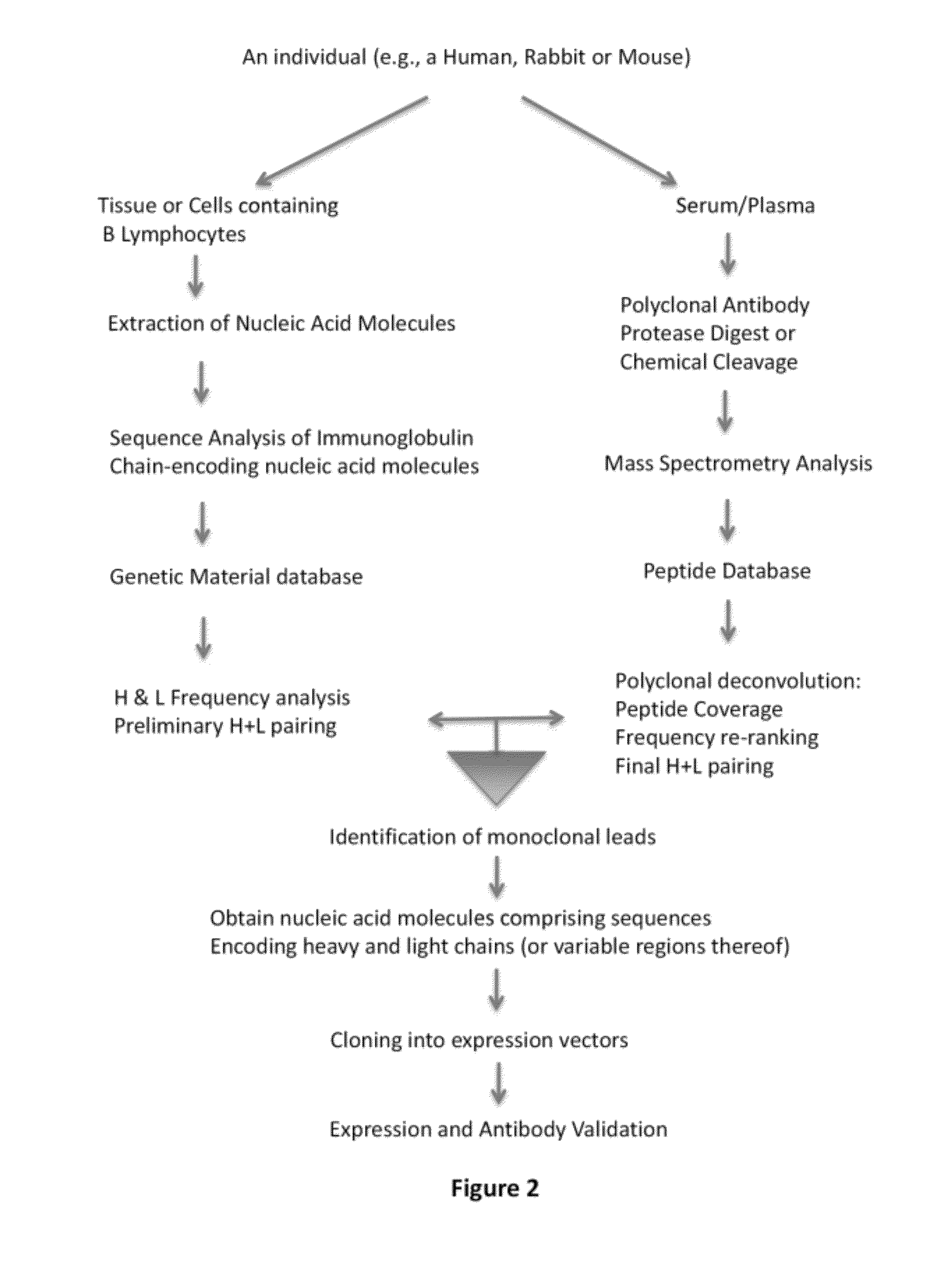Methods and reagents for creating monoclonal antibodies
a monoclonal antibody and antibody technology, applied in the field of biological sciences, can solve the problems of time-consuming and laborious, arduous and time-consuming, and achieve the effect of reducing the likelihood of occurren
- Summary
- Abstract
- Description
- Claims
- Application Information
AI Technical Summary
Benefits of technology
Problems solved by technology
Method used
Image
Examples
example 1
Identifying Individual Antibody Heavy Chains from a Polyclonal Population of Antibodies that Specifically Bind an Antigen
[0201]In this example, multiple monoclonal antibodies were derived from a polyclonal population of antibodies that specifically bound an antigen. Using the methods of various embodiments of the invention, the information from the genetic material database generated from nucleic acid molecules from the animal whose sera comprised the starting polyclonal population were compared to peptide database information from analysis of the monoclonal antibodies.
[0202]The nucleic acid sequences were obtained from splenocytes from an animal immunized with the antigen according to the methods described herein using primers specific for rabbit immunoglobulin chain-encoding sequences (see, for example, the primer sequences in Example 6 below). The CDR3 regions from the heavy chains of the polyclonal antibodies were ranked based on the number of times they appeared in the database...
example 2
Development of an Influenza Antigen-Specific Recombinant Human Antibody
[0209]During the winter of 2009-2010, a strain of H1N1 influenza virus infected a large number of humans, causing death and permanent injury. Using the non-limiting methods of various embodiments of the invention, neutralizing antibodies may be cloned from humans previously exposed to a similar virus strain, and used as a composition to treat human patients currently suffering from the disease.
[0210]Accordingly, elderly individuals who were known to have been exposed to the influenza virus during the 1918 influenza epidemic are screened for the presence of serum antibodies that can neutralize the 1918 virus. To do this, the method described in Yu et al., Nature 455: 532-536, 2008 (and online supplement; article and supplement incorporated herein by reference in their entirety) is followed.
[0211]Patients whose blood serum and / or plasma contains virus-neutralizing antibodies are identified, and blood is taken from ...
example 3
Obtaining Nucleic Acid Sequences
[0216]This protocol uses next generation sequencing (NGS), and is based on 454 NGS platform (FLX+, FLX or junior; commercially available from 454 Life Sciences, a Roche company, Branford, Conn.). Slight modifications will be needed for other high throughput NGS platforms and will be based on NGS manufacturing's instructions.
[0217]Mice are immunized with antigen of interest (peptide(s), recombinant proteins, virus, toxin, etc) with standard immunization protocols (see, e.g., Coligan et al., supra). Immune responses are monitored by plasma immunoglobulins titer against the specific antigen. Blood, spleen, bone marrow, lymph nodes, or any lymphoid organs can be collected and processed to isolate B cells according to standard methods. This isolation procedure can also be reduced if material is limited and replaced with a direct RT-PCR procedure using immunoglobulin variable domain specific PCR primers against heavy and light chains populations from the an...
PUM
| Property | Measurement | Unit |
|---|---|---|
| Time | aaaaa | aaaaa |
| Nucleic acid sequence | aaaaa | aaaaa |
| Frequency | aaaaa | aaaaa |
Abstract
Description
Claims
Application Information
 Login to View More
Login to View More - R&D
- Intellectual Property
- Life Sciences
- Materials
- Tech Scout
- Unparalleled Data Quality
- Higher Quality Content
- 60% Fewer Hallucinations
Browse by: Latest US Patents, China's latest patents, Technical Efficacy Thesaurus, Application Domain, Technology Topic, Popular Technical Reports.
© 2025 PatSnap. All rights reserved.Legal|Privacy policy|Modern Slavery Act Transparency Statement|Sitemap|About US| Contact US: help@patsnap.com



